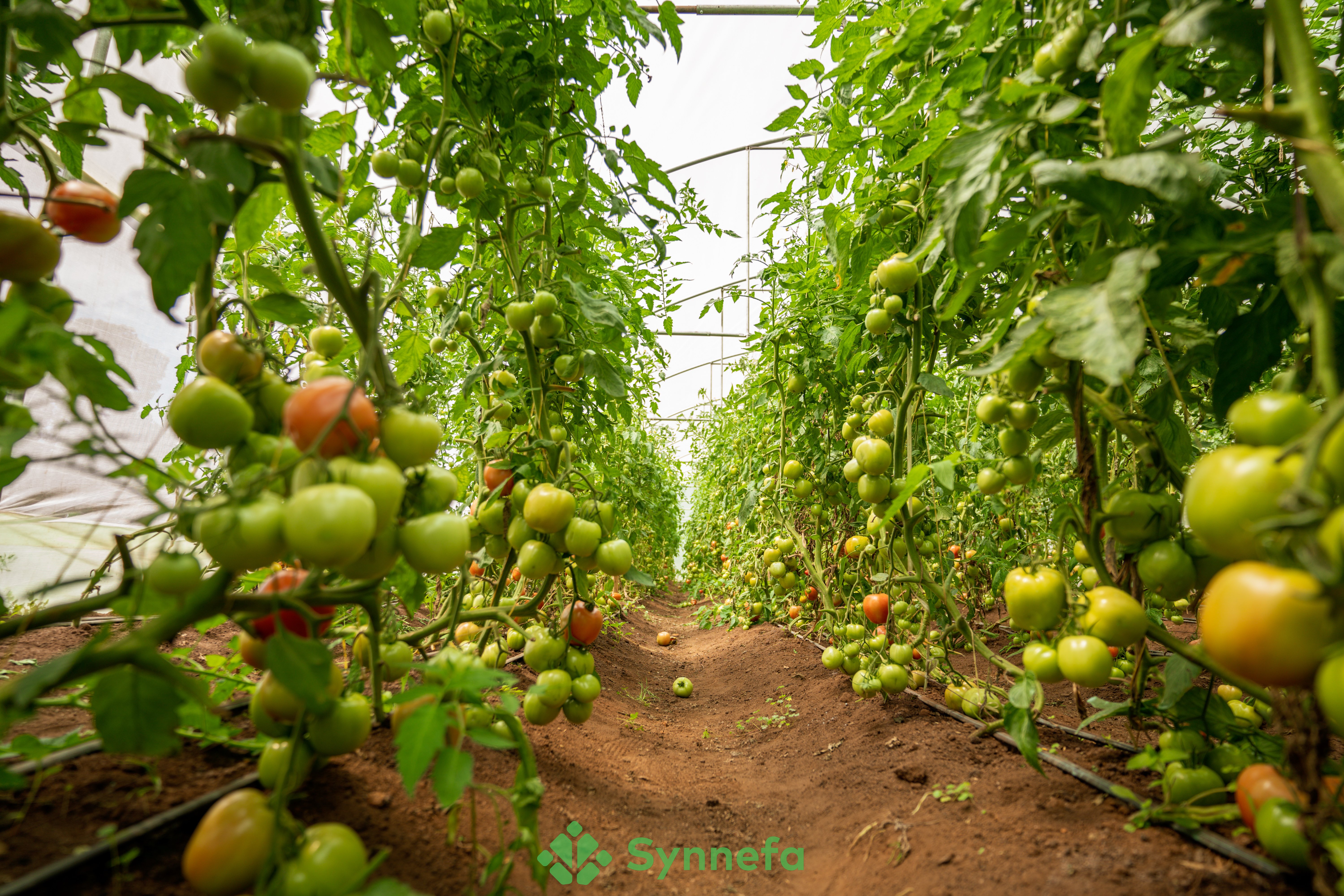8 Tips to Get High Yields From Your Greenhouse

Greenhouses are a farmer’s best friend. They provide a controlled environment that extends the growing season and protects plants from harsh weather conditions. However, to maximise yields in a greenhouse requires more than just planting seeds and watering them. The question remains, what are the best tips to get the most yields from a greenhouse?
1. Choose the Right Crops
The right crops gets you a bountiful harvest. Consider crops that thrive in the controlled environment of a greenhouse such as tomatoes, peppers, cucumbers, lettuce, herbs and strawberries. These plants tend to perform well under the consistent temperatures and humidity levels that greenhouses offer.

A Chemondin Women Group farmer holding quality greenhouse tomatoes courtesy of Synnefa
Pro Tip: Opt for high-yielding and disease-resistant varieties to maximize your output and minimize losses.
2. Optimise Light Exposure
Ensure your greenhouse is positioned to receive ample sunlight throughout the day. Clean the greenhouse panels regularly to remove any dust, dirt or algae that may reduce light penetration.
If natural light is insufficient, consider supplementing with artificial grow lights. LED lights are a popular choice as they are energy-efficient and provide the specific light spectrum needed for plant growth.
Pro Tip: Use reflective materials on the walls and floor of your greenhouse to bounce light back onto your plants, maximizing light availability.
3. Control Temperature and Humidity
Most vegetables and fruits thrive at temperatures between 70°F and 85°F (21°C to 29°C) during the day and slightly cooler at night. Install a thermostat to monitor and regulate the temperature inside your greenhouse.
High humidity can lead to fungal diseases. Low humidity can stress plants. Use a hygrometer to monitor humidity levels. You can consider installing ventilation fans or a dehumidifier to maintain the right balance.
For a simplified temperature and humidity monitor, use Synnefa's AI Powered Farmshield.

Pro Tip: In hot climates, use shade cloths to prevent overheating, and in cold climates, invest in a heating system to keep temperatures stable.
4. Implement Efficient Watering or Irrigation Systems
Overwatering or underwatering can stress plants and reduce productivity. Drip irrigation systems are ideal for greenhouses as they deliver water directly to the plant roots, minimizing evaporation and ensuring consistent moisture levels.
Consider smart systems that allow monitoring water supply to the plants remotely. Synnefa AI Powered Farmshield helps farmers be able to monitor and regulate water usage in the greenhouse even when you are away from your farm.
Pro Tip: Use a timer for your irrigation system to ensure consistent watering, especially during times when you may not be available to tend to your plants.
5. Regularly Prune and Train Plants
Pruning and training plants helps improve airflow, reduce disease risk and encourage higher yields. For crops like tomatoes, cucumbers, and peppers, regularly remove side shoots (suckers) and train the plants to grow vertically. This allows more light to reach the fruiting branches and reduces the likelihood of disease.
Pro Tip: Use trellises, stakes, or cages to support your plants as they grow. This not only saves space but also prevents the plants from sprawling and becoming unmanageable.
6. Rotate Crops and Practice Companion Planting
Planting the same crop in the same spot season after season can lead to soil depletion and an increased risk of pests and diseases. Rotate your crops to different areas of the greenhouse each season to keep the soil healthy and productive.
Companion planting is another effective strategy to boost yields. Certain plants, when grown together, can enhance each other’s growth and protect against pests. For example, basil planted near tomatoes can improve tomato flavor and deter pests.
Pro Tip: Keep detailed records of your planting schedule and crop locations to ensure effective crop rotation and companion planting each season.
7. Feed Your Plants With Organic Fertilizers
To achieve high yields, your plants need a steady supply of nutrients. Organic fertilizers, such as compost, worm castings and fish emulsion, are excellent choices for feeding your greenhouse plants. These natural fertilizers provide essential nutrients without the risk of chemical buildup in the soil.
Regularly test your soil to monitor nutrient levels and adjust your fertilization routine accordingly. A well-balanced diet of nitrogen, phosphorus, and potassium, along with trace minerals, will keep your plants healthy and productive.
Pro Tip: Use liquid organic fertilizers for a quick nutrient boost, especially during the flowering and fruiting stages.
8. Monitor for Pests and Diseases
A greenhouse may provide a protective environment, but it’s not immune to pests and diseases. Regularly inspect your plants for signs of trouble, such as yellowing leaves, wilting, or unusual spots. Early detection is key to preventing widespread damage.
Introduce beneficial insects, such as ladybugs and predatory mites, to control pests naturally. Sticky traps can also be used to monitor and catch flying insects. If you spot a disease, remove and dispose of affected plants immediately to prevent it from spreading.
Pro Tip: Keep your greenhouse clean and free of debris, which can harbor pests and diseases. Regularly disinfect tools and equipment to reduce the risk of contamination.
Point to Note
Your greenhouse can become a powerhouse of production, providing you with bountiful harvests throughout the year if you follow these 8 tips.


